Mind Mapping and Learning Styles for Effective Academic Skills
VerifiedAdded on 2023/06/14
|8
|2491
|301
Essay
AI Summary
This essay explores the significance of academic learning and various study skills essential for personal and professional growth. It discusses different learning styles, including visual, auditory, kinaesthetic, and reading/writing, highlighting the author's preference for visual learning. The CREAM model (Creativity, Reflective, Effective, Active, Motivated) is examined as a framework for enhancing learning capabilities. The essay also addresses the importance of time and stress management, brain capabilities, and potential mental and emotional challenges that can impact learning. Furthermore, it emphasizes the role of mind mapping as a tool for structuring thoughts, improving memory retention, and fostering creativity, providing practical applications and steps for designing effective mind maps. The conclusion reiterates the value of academic learning, brain capabilities, and mind mapping in enhancing a learner's overall performance.
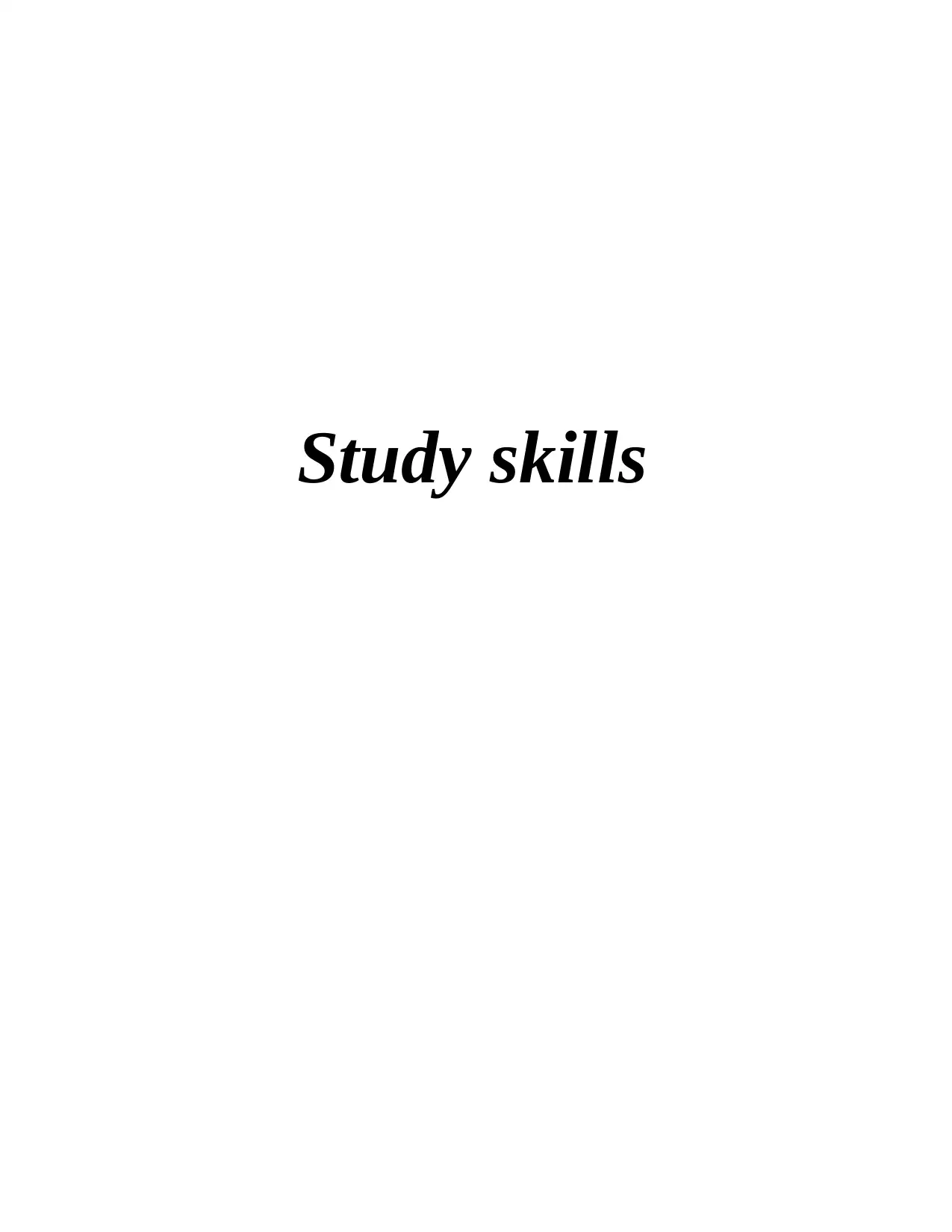
Study skills
Paraphrase This Document
Need a fresh take? Get an instant paraphrase of this document with our AI Paraphraser
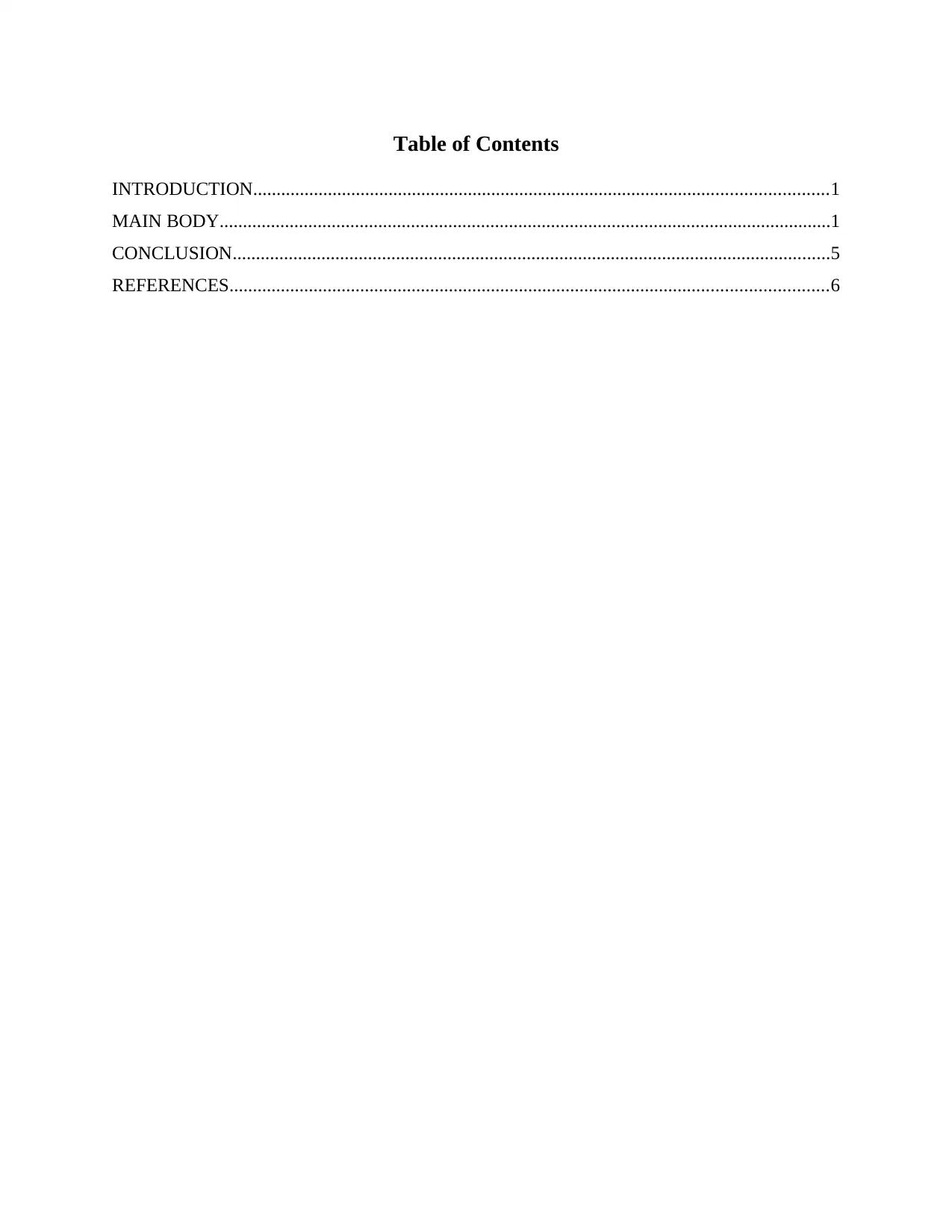
Table of Contents
INTRODUCTION...........................................................................................................................1
MAIN BODY...................................................................................................................................1
CONCLUSION................................................................................................................................5
REFERENCES................................................................................................................................6
INTRODUCTION...........................................................................................................................1
MAIN BODY...................................................................................................................................1
CONCLUSION................................................................................................................................5
REFERENCES................................................................................................................................6
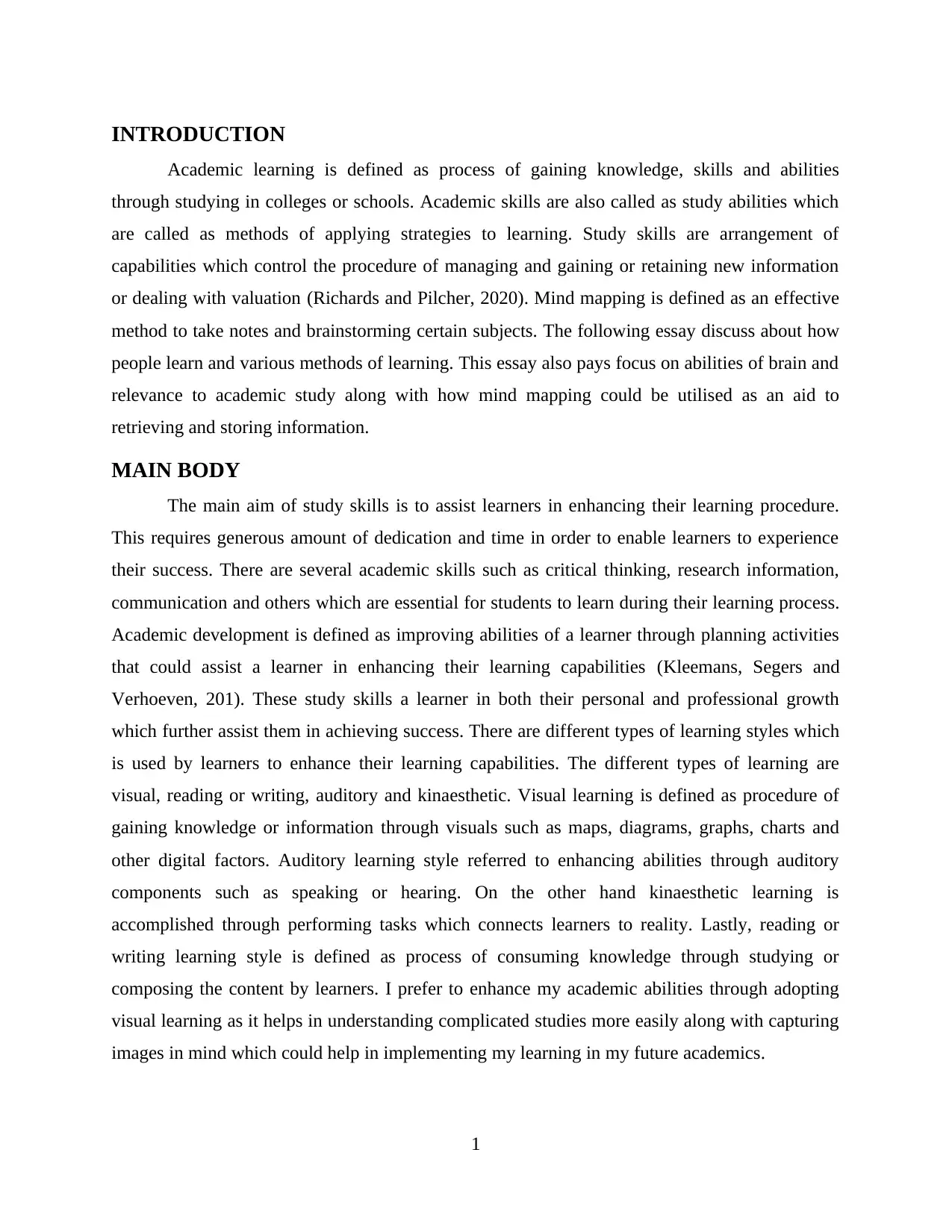
INTRODUCTION
Academic learning is defined as process of gaining knowledge, skills and abilities
through studying in colleges or schools. Academic skills are also called as study abilities which
are called as methods of applying strategies to learning. Study skills are arrangement of
capabilities which control the procedure of managing and gaining or retaining new information
or dealing with valuation (Richards and Pilcher, 2020). Mind mapping is defined as an effective
method to take notes and brainstorming certain subjects. The following essay discuss about how
people learn and various methods of learning. This essay also pays focus on abilities of brain and
relevance to academic study along with how mind mapping could be utilised as an aid to
retrieving and storing information.
MAIN BODY
The main aim of study skills is to assist learners in enhancing their learning procedure.
This requires generous amount of dedication and time in order to enable learners to experience
their success. There are several academic skills such as critical thinking, research information,
communication and others which are essential for students to learn during their learning process.
Academic development is defined as improving abilities of a learner through planning activities
that could assist a learner in enhancing their learning capabilities (Kleemans, Segers and
Verhoeven, 201). These study skills a learner in both their personal and professional growth
which further assist them in achieving success. There are different types of learning styles which
is used by learners to enhance their learning capabilities. The different types of learning are
visual, reading or writing, auditory and kinaesthetic. Visual learning is defined as procedure of
gaining knowledge or information through visuals such as maps, diagrams, graphs, charts and
other digital factors. Auditory learning style referred to enhancing abilities through auditory
components such as speaking or hearing. On the other hand kinaesthetic learning is
accomplished through performing tasks which connects learners to reality. Lastly, reading or
writing learning style is defined as process of consuming knowledge through studying or
composing the content by learners. I prefer to enhance my academic abilities through adopting
visual learning as it helps in understanding complicated studies more easily along with capturing
images in mind which could help in implementing my learning in my future academics.
1
Academic learning is defined as process of gaining knowledge, skills and abilities
through studying in colleges or schools. Academic skills are also called as study abilities which
are called as methods of applying strategies to learning. Study skills are arrangement of
capabilities which control the procedure of managing and gaining or retaining new information
or dealing with valuation (Richards and Pilcher, 2020). Mind mapping is defined as an effective
method to take notes and brainstorming certain subjects. The following essay discuss about how
people learn and various methods of learning. This essay also pays focus on abilities of brain and
relevance to academic study along with how mind mapping could be utilised as an aid to
retrieving and storing information.
MAIN BODY
The main aim of study skills is to assist learners in enhancing their learning procedure.
This requires generous amount of dedication and time in order to enable learners to experience
their success. There are several academic skills such as critical thinking, research information,
communication and others which are essential for students to learn during their learning process.
Academic development is defined as improving abilities of a learner through planning activities
that could assist a learner in enhancing their learning capabilities (Kleemans, Segers and
Verhoeven, 201). These study skills a learner in both their personal and professional growth
which further assist them in achieving success. There are different types of learning styles which
is used by learners to enhance their learning capabilities. The different types of learning are
visual, reading or writing, auditory and kinaesthetic. Visual learning is defined as procedure of
gaining knowledge or information through visuals such as maps, diagrams, graphs, charts and
other digital factors. Auditory learning style referred to enhancing abilities through auditory
components such as speaking or hearing. On the other hand kinaesthetic learning is
accomplished through performing tasks which connects learners to reality. Lastly, reading or
writing learning style is defined as process of consuming knowledge through studying or
composing the content by learners. I prefer to enhance my academic abilities through adopting
visual learning as it helps in understanding complicated studies more easily along with capturing
images in mind which could help in implementing my learning in my future academics.
1
⊘ This is a preview!⊘
Do you want full access?
Subscribe today to unlock all pages.

Trusted by 1+ million students worldwide
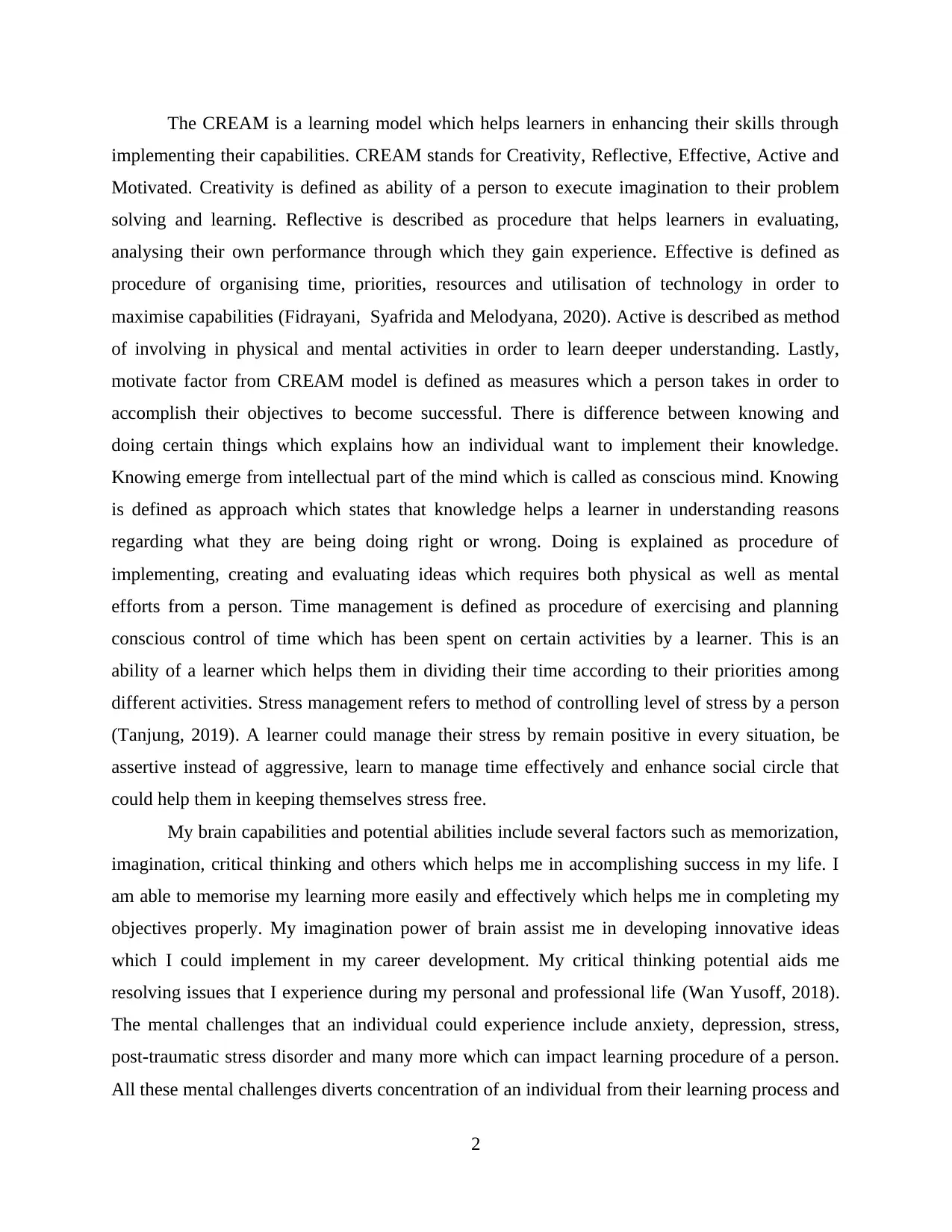
The CREAM is a learning model which helps learners in enhancing their skills through
implementing their capabilities. CREAM stands for Creativity, Reflective, Effective, Active and
Motivated. Creativity is defined as ability of a person to execute imagination to their problem
solving and learning. Reflective is described as procedure that helps learners in evaluating,
analysing their own performance through which they gain experience. Effective is defined as
procedure of organising time, priorities, resources and utilisation of technology in order to
maximise capabilities (Fidrayani, Syafrida and Melodyana, 2020). Active is described as method
of involving in physical and mental activities in order to learn deeper understanding. Lastly,
motivate factor from CREAM model is defined as measures which a person takes in order to
accomplish their objectives to become successful. There is difference between knowing and
doing certain things which explains how an individual want to implement their knowledge.
Knowing emerge from intellectual part of the mind which is called as conscious mind. Knowing
is defined as approach which states that knowledge helps a learner in understanding reasons
regarding what they are being doing right or wrong. Doing is explained as procedure of
implementing, creating and evaluating ideas which requires both physical as well as mental
efforts from a person. Time management is defined as procedure of exercising and planning
conscious control of time which has been spent on certain activities by a learner. This is an
ability of a learner which helps them in dividing their time according to their priorities among
different activities. Stress management refers to method of controlling level of stress by a person
(Tanjung, 2019). A learner could manage their stress by remain positive in every situation, be
assertive instead of aggressive, learn to manage time effectively and enhance social circle that
could help them in keeping themselves stress free.
My brain capabilities and potential abilities include several factors such as memorization,
imagination, critical thinking and others which helps me in accomplishing success in my life. I
am able to memorise my learning more easily and effectively which helps me in completing my
objectives properly. My imagination power of brain assist me in developing innovative ideas
which I could implement in my career development. My critical thinking potential aids me
resolving issues that I experience during my personal and professional life (Wan Yusoff, 2018).
The mental challenges that an individual could experience include anxiety, depression, stress,
post-traumatic stress disorder and many more which can impact learning procedure of a person.
All these mental challenges diverts concentration of an individual from their learning process and
2
implementing their capabilities. CREAM stands for Creativity, Reflective, Effective, Active and
Motivated. Creativity is defined as ability of a person to execute imagination to their problem
solving and learning. Reflective is described as procedure that helps learners in evaluating,
analysing their own performance through which they gain experience. Effective is defined as
procedure of organising time, priorities, resources and utilisation of technology in order to
maximise capabilities (Fidrayani, Syafrida and Melodyana, 2020). Active is described as method
of involving in physical and mental activities in order to learn deeper understanding. Lastly,
motivate factor from CREAM model is defined as measures which a person takes in order to
accomplish their objectives to become successful. There is difference between knowing and
doing certain things which explains how an individual want to implement their knowledge.
Knowing emerge from intellectual part of the mind which is called as conscious mind. Knowing
is defined as approach which states that knowledge helps a learner in understanding reasons
regarding what they are being doing right or wrong. Doing is explained as procedure of
implementing, creating and evaluating ideas which requires both physical as well as mental
efforts from a person. Time management is defined as procedure of exercising and planning
conscious control of time which has been spent on certain activities by a learner. This is an
ability of a learner which helps them in dividing their time according to their priorities among
different activities. Stress management refers to method of controlling level of stress by a person
(Tanjung, 2019). A learner could manage their stress by remain positive in every situation, be
assertive instead of aggressive, learn to manage time effectively and enhance social circle that
could help them in keeping themselves stress free.
My brain capabilities and potential abilities include several factors such as memorization,
imagination, critical thinking and others which helps me in accomplishing success in my life. I
am able to memorise my learning more easily and effectively which helps me in completing my
objectives properly. My imagination power of brain assist me in developing innovative ideas
which I could implement in my career development. My critical thinking potential aids me
resolving issues that I experience during my personal and professional life (Wan Yusoff, 2018).
The mental challenges that an individual could experience include anxiety, depression, stress,
post-traumatic stress disorder and many more which can impact learning procedure of a person.
All these mental challenges diverts concentration of an individual from their learning process and
2
Paraphrase This Document
Need a fresh take? Get an instant paraphrase of this document with our AI Paraphraser
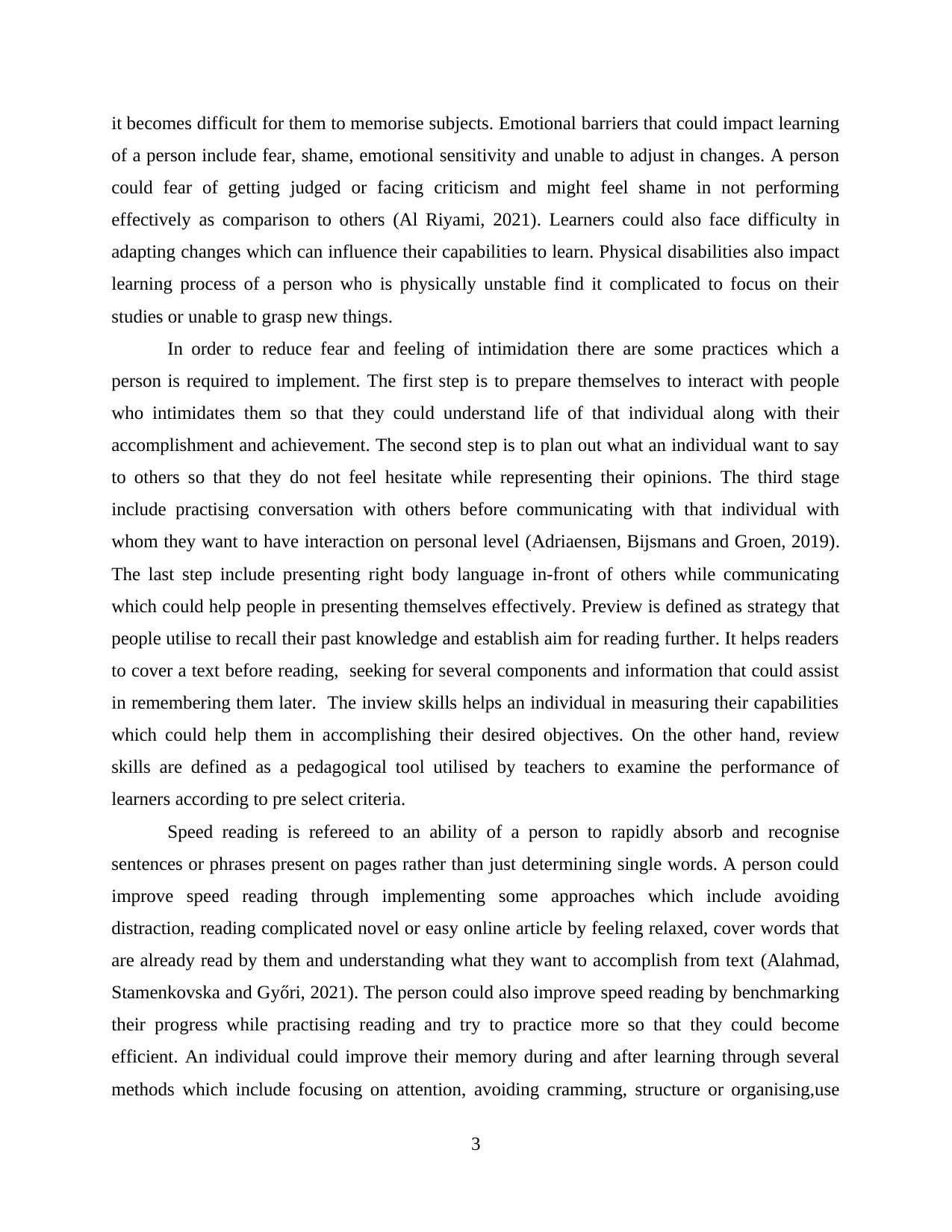
it becomes difficult for them to memorise subjects. Emotional barriers that could impact learning
of a person include fear, shame, emotional sensitivity and unable to adjust in changes. A person
could fear of getting judged or facing criticism and might feel shame in not performing
effectively as comparison to others (Al Riyami, 2021). Learners could also face difficulty in
adapting changes which can influence their capabilities to learn. Physical disabilities also impact
learning process of a person who is physically unstable find it complicated to focus on their
studies or unable to grasp new things.
In order to reduce fear and feeling of intimidation there are some practices which a
person is required to implement. The first step is to prepare themselves to interact with people
who intimidates them so that they could understand life of that individual along with their
accomplishment and achievement. The second step is to plan out what an individual want to say
to others so that they do not feel hesitate while representing their opinions. The third stage
include practising conversation with others before communicating with that individual with
whom they want to have interaction on personal level (Adriaensen, Bijsmans and Groen, 2019).
The last step include presenting right body language in-front of others while communicating
which could help people in presenting themselves effectively. Preview is defined as strategy that
people utilise to recall their past knowledge and establish aim for reading further. It helps readers
to cover a text before reading, seeking for several components and information that could assist
in remembering them later. The inview skills helps an individual in measuring their capabilities
which could help them in accomplishing their desired objectives. On the other hand, review
skills are defined as a pedagogical tool utilised by teachers to examine the performance of
learners according to pre select criteria.
Speed reading is refereed to an ability of a person to rapidly absorb and recognise
sentences or phrases present on pages rather than just determining single words. A person could
improve speed reading through implementing some approaches which include avoiding
distraction, reading complicated novel or easy online article by feeling relaxed, cover words that
are already read by them and understanding what they want to accomplish from text (Alahmad,
Stamenkovska and Győri, 2021). The person could also improve speed reading by benchmarking
their progress while practising reading and try to practice more so that they could become
efficient. An individual could improve their memory during and after learning through several
methods which include focusing on attention, avoiding cramming, structure or organising,use
3
of a person include fear, shame, emotional sensitivity and unable to adjust in changes. A person
could fear of getting judged or facing criticism and might feel shame in not performing
effectively as comparison to others (Al Riyami, 2021). Learners could also face difficulty in
adapting changes which can influence their capabilities to learn. Physical disabilities also impact
learning process of a person who is physically unstable find it complicated to focus on their
studies or unable to grasp new things.
In order to reduce fear and feeling of intimidation there are some practices which a
person is required to implement. The first step is to prepare themselves to interact with people
who intimidates them so that they could understand life of that individual along with their
accomplishment and achievement. The second step is to plan out what an individual want to say
to others so that they do not feel hesitate while representing their opinions. The third stage
include practising conversation with others before communicating with that individual with
whom they want to have interaction on personal level (Adriaensen, Bijsmans and Groen, 2019).
The last step include presenting right body language in-front of others while communicating
which could help people in presenting themselves effectively. Preview is defined as strategy that
people utilise to recall their past knowledge and establish aim for reading further. It helps readers
to cover a text before reading, seeking for several components and information that could assist
in remembering them later. The inview skills helps an individual in measuring their capabilities
which could help them in accomplishing their desired objectives. On the other hand, review
skills are defined as a pedagogical tool utilised by teachers to examine the performance of
learners according to pre select criteria.
Speed reading is refereed to an ability of a person to rapidly absorb and recognise
sentences or phrases present on pages rather than just determining single words. A person could
improve speed reading through implementing some approaches which include avoiding
distraction, reading complicated novel or easy online article by feeling relaxed, cover words that
are already read by them and understanding what they want to accomplish from text (Alahmad,
Stamenkovska and Győri, 2021). The person could also improve speed reading by benchmarking
their progress while practising reading and try to practice more so that they could become
efficient. An individual could improve their memory during and after learning through several
methods which include focusing on attention, avoiding cramming, structure or organising,use
3
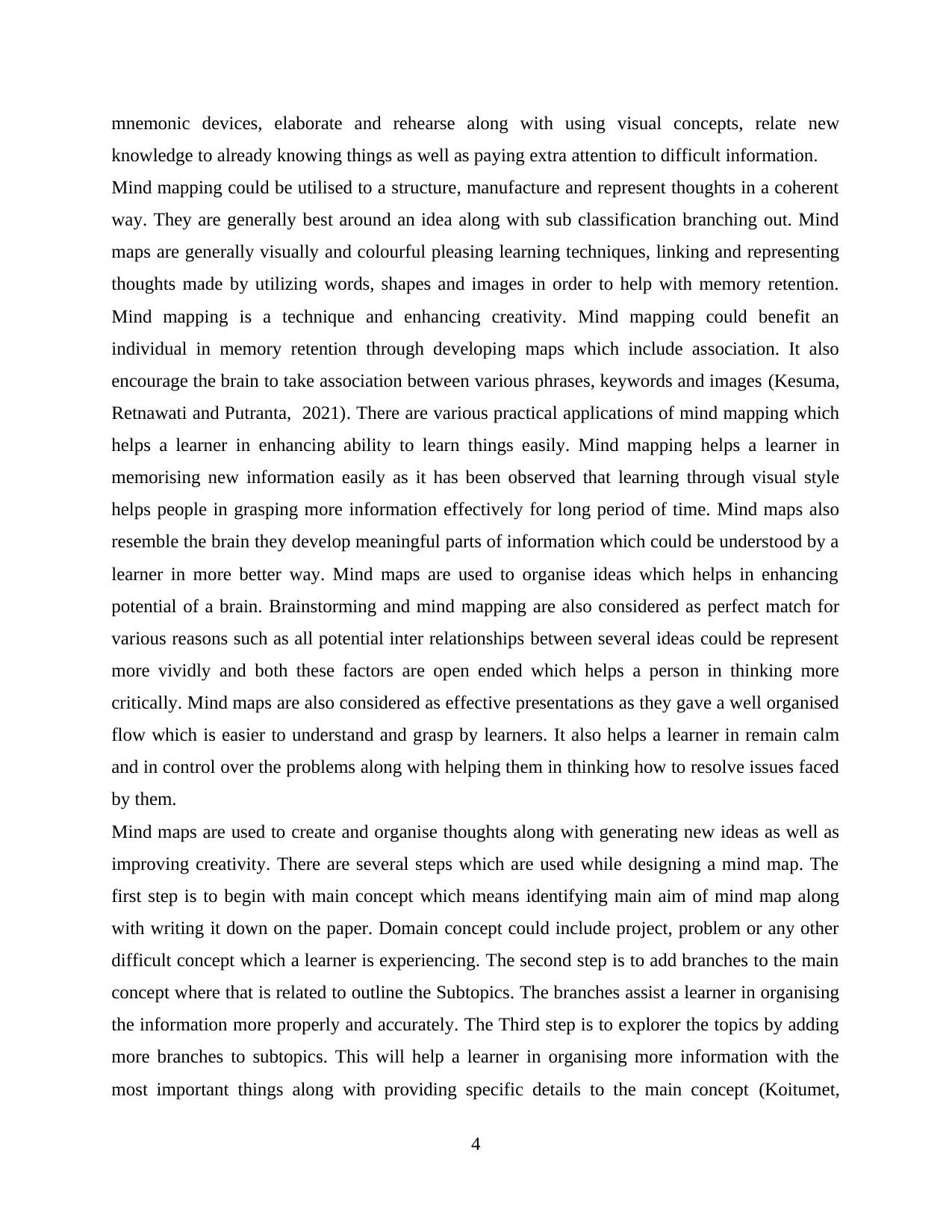
mnemonic devices, elaborate and rehearse along with using visual concepts, relate new
knowledge to already knowing things as well as paying extra attention to difficult information.
Mind mapping could be utilised to a structure, manufacture and represent thoughts in a coherent
way. They are generally best around an idea along with sub classification branching out. Mind
maps are generally visually and colourful pleasing learning techniques, linking and representing
thoughts made by utilizing words, shapes and images in order to help with memory retention.
Mind mapping is a technique and enhancing creativity. Mind mapping could benefit an
individual in memory retention through developing maps which include association. It also
encourage the brain to take association between various phrases, keywords and images (Kesuma,
Retnawati and Putranta, 2021). There are various practical applications of mind mapping which
helps a learner in enhancing ability to learn things easily. Mind mapping helps a learner in
memorising new information easily as it has been observed that learning through visual style
helps people in grasping more information effectively for long period of time. Mind maps also
resemble the brain they develop meaningful parts of information which could be understood by a
learner in more better way. Mind maps are used to organise ideas which helps in enhancing
potential of a brain. Brainstorming and mind mapping are also considered as perfect match for
various reasons such as all potential inter relationships between several ideas could be represent
more vividly and both these factors are open ended which helps a person in thinking more
critically. Mind maps are also considered as effective presentations as they gave a well organised
flow which is easier to understand and grasp by learners. It also helps a learner in remain calm
and in control over the problems along with helping them in thinking how to resolve issues faced
by them.
Mind maps are used to create and organise thoughts along with generating new ideas as well as
improving creativity. There are several steps which are used while designing a mind map. The
first step is to begin with main concept which means identifying main aim of mind map along
with writing it down on the paper. Domain concept could include project, problem or any other
difficult concept which a learner is experiencing. The second step is to add branches to the main
concept where that is related to outline the Subtopics. The branches assist a learner in organising
the information more properly and accurately. The Third step is to explorer the topics by adding
more branches to subtopics. This will help a learner in organising more information with the
most important things along with providing specific details to the main concept (Koitumet,
4
knowledge to already knowing things as well as paying extra attention to difficult information.
Mind mapping could be utilised to a structure, manufacture and represent thoughts in a coherent
way. They are generally best around an idea along with sub classification branching out. Mind
maps are generally visually and colourful pleasing learning techniques, linking and representing
thoughts made by utilizing words, shapes and images in order to help with memory retention.
Mind mapping is a technique and enhancing creativity. Mind mapping could benefit an
individual in memory retention through developing maps which include association. It also
encourage the brain to take association between various phrases, keywords and images (Kesuma,
Retnawati and Putranta, 2021). There are various practical applications of mind mapping which
helps a learner in enhancing ability to learn things easily. Mind mapping helps a learner in
memorising new information easily as it has been observed that learning through visual style
helps people in grasping more information effectively for long period of time. Mind maps also
resemble the brain they develop meaningful parts of information which could be understood by a
learner in more better way. Mind maps are used to organise ideas which helps in enhancing
potential of a brain. Brainstorming and mind mapping are also considered as perfect match for
various reasons such as all potential inter relationships between several ideas could be represent
more vividly and both these factors are open ended which helps a person in thinking more
critically. Mind maps are also considered as effective presentations as they gave a well organised
flow which is easier to understand and grasp by learners. It also helps a learner in remain calm
and in control over the problems along with helping them in thinking how to resolve issues faced
by them.
Mind maps are used to create and organise thoughts along with generating new ideas as well as
improving creativity. There are several steps which are used while designing a mind map. The
first step is to begin with main concept which means identifying main aim of mind map along
with writing it down on the paper. Domain concept could include project, problem or any other
difficult concept which a learner is experiencing. The second step is to add branches to the main
concept where that is related to outline the Subtopics. The branches assist a learner in organising
the information more properly and accurately. The Third step is to explorer the topics by adding
more branches to subtopics. This will help a learner in organising more information with the
most important things along with providing specific details to the main concept (Koitumet,
4
⊘ This is a preview!⊘
Do you want full access?
Subscribe today to unlock all pages.

Trusted by 1+ million students worldwide
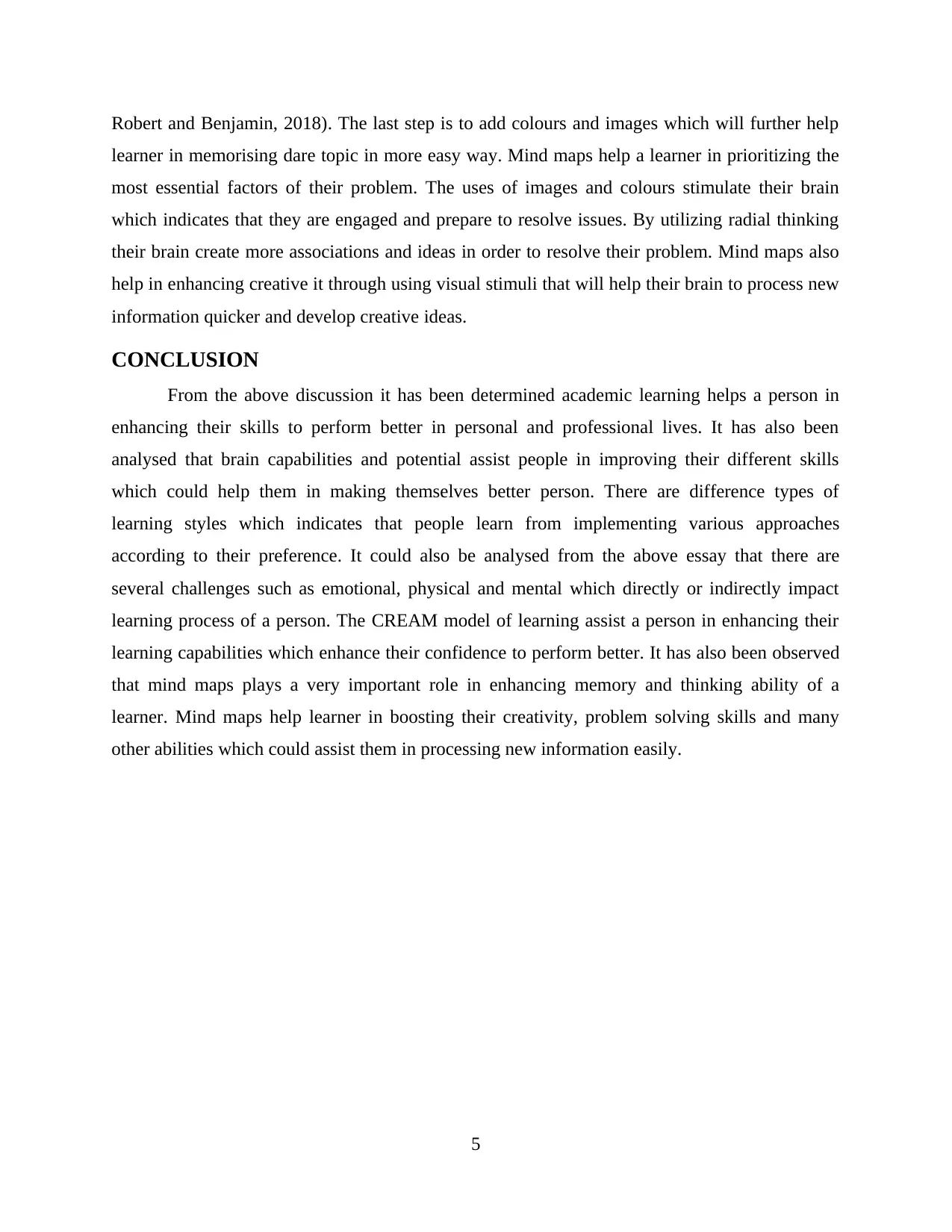
Robert and Benjamin, 2018). The last step is to add colours and images which will further help
learner in memorising dare topic in more easy way. Mind maps help a learner in prioritizing the
most essential factors of their problem. The uses of images and colours stimulate their brain
which indicates that they are engaged and prepare to resolve issues. By utilizing radial thinking
their brain create more associations and ideas in order to resolve their problem. Mind maps also
help in enhancing creative it through using visual stimuli that will help their brain to process new
information quicker and develop creative ideas.
CONCLUSION
From the above discussion it has been determined academic learning helps a person in
enhancing their skills to perform better in personal and professional lives. It has also been
analysed that brain capabilities and potential assist people in improving their different skills
which could help them in making themselves better person. There are difference types of
learning styles which indicates that people learn from implementing various approaches
according to their preference. It could also be analysed from the above essay that there are
several challenges such as emotional, physical and mental which directly or indirectly impact
learning process of a person. The CREAM model of learning assist a person in enhancing their
learning capabilities which enhance their confidence to perform better. It has also been observed
that mind maps plays a very important role in enhancing memory and thinking ability of a
learner. Mind maps help learner in boosting their creativity, problem solving skills and many
other abilities which could assist them in processing new information easily.
5
learner in memorising dare topic in more easy way. Mind maps help a learner in prioritizing the
most essential factors of their problem. The uses of images and colours stimulate their brain
which indicates that they are engaged and prepare to resolve issues. By utilizing radial thinking
their brain create more associations and ideas in order to resolve their problem. Mind maps also
help in enhancing creative it through using visual stimuli that will help their brain to process new
information quicker and develop creative ideas.
CONCLUSION
From the above discussion it has been determined academic learning helps a person in
enhancing their skills to perform better in personal and professional lives. It has also been
analysed that brain capabilities and potential assist people in improving their different skills
which could help them in making themselves better person. There are difference types of
learning styles which indicates that people learn from implementing various approaches
according to their preference. It could also be analysed from the above essay that there are
several challenges such as emotional, physical and mental which directly or indirectly impact
learning process of a person. The CREAM model of learning assist a person in enhancing their
learning capabilities which enhance their confidence to perform better. It has also been observed
that mind maps plays a very important role in enhancing memory and thinking ability of a
learner. Mind maps help learner in boosting their creativity, problem solving skills and many
other abilities which could assist them in processing new information easily.
5
Paraphrase This Document
Need a fresh take? Get an instant paraphrase of this document with our AI Paraphraser
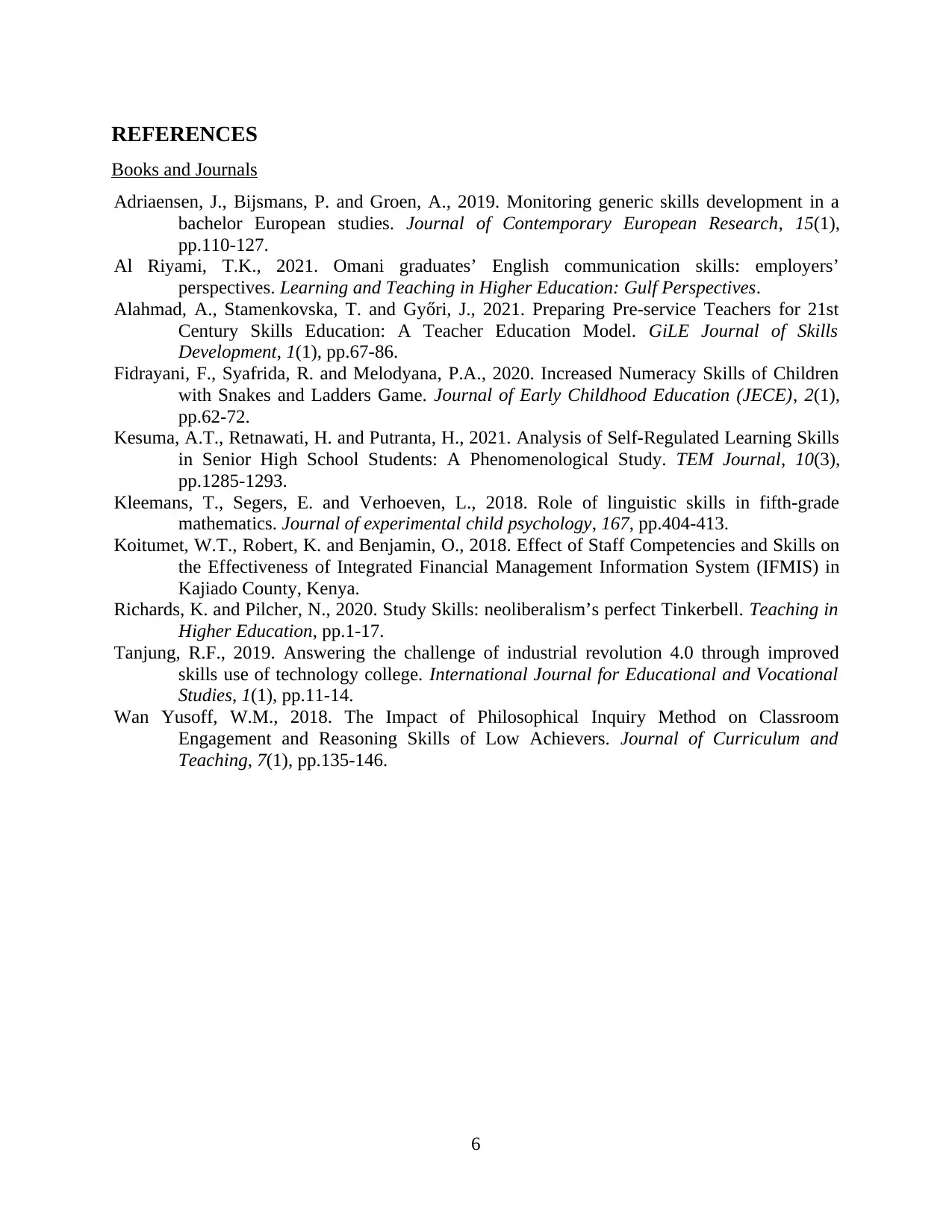
REFERENCES
Books and Journals
Adriaensen, J., Bijsmans, P. and Groen, A., 2019. Monitoring generic skills development in a
bachelor European studies. Journal of Contemporary European Research, 15(1),
pp.110-127.
Al Riyami, T.K., 2021. Omani graduates’ English communication skills: employers’
perspectives. Learning and Teaching in Higher Education: Gulf Perspectives.
Alahmad, A., Stamenkovska, T. and Győri, J., 2021. Preparing Pre-service Teachers for 21st
Century Skills Education: A Teacher Education Model. GiLE Journal of Skills
Development, 1(1), pp.67-86.
Fidrayani, F., Syafrida, R. and Melodyana, P.A., 2020. Increased Numeracy Skills of Children
with Snakes and Ladders Game. Journal of Early Childhood Education (JECE), 2(1),
pp.62-72.
Kesuma, A.T., Retnawati, H. and Putranta, H., 2021. Analysis of Self-Regulated Learning Skills
in Senior High School Students: A Phenomenological Study. TEM Journal, 10(3),
pp.1285-1293.
Kleemans, T., Segers, E. and Verhoeven, L., 2018. Role of linguistic skills in fifth-grade
mathematics. Journal of experimental child psychology, 167, pp.404-413.
Koitumet, W.T., Robert, K. and Benjamin, O., 2018. Effect of Staff Competencies and Skills on
the Effectiveness of Integrated Financial Management Information System (IFMIS) in
Kajiado County, Kenya.
Richards, K. and Pilcher, N., 2020. Study Skills: neoliberalism’s perfect Tinkerbell. Teaching in
Higher Education, pp.1-17.
Tanjung, R.F., 2019. Answering the challenge of industrial revolution 4.0 through improved
skills use of technology college. International Journal for Educational and Vocational
Studies, 1(1), pp.11-14.
Wan Yusoff, W.M., 2018. The Impact of Philosophical Inquiry Method on Classroom
Engagement and Reasoning Skills of Low Achievers. Journal of Curriculum and
Teaching, 7(1), pp.135-146.
6
Books and Journals
Adriaensen, J., Bijsmans, P. and Groen, A., 2019. Monitoring generic skills development in a
bachelor European studies. Journal of Contemporary European Research, 15(1),
pp.110-127.
Al Riyami, T.K., 2021. Omani graduates’ English communication skills: employers’
perspectives. Learning and Teaching in Higher Education: Gulf Perspectives.
Alahmad, A., Stamenkovska, T. and Győri, J., 2021. Preparing Pre-service Teachers for 21st
Century Skills Education: A Teacher Education Model. GiLE Journal of Skills
Development, 1(1), pp.67-86.
Fidrayani, F., Syafrida, R. and Melodyana, P.A., 2020. Increased Numeracy Skills of Children
with Snakes and Ladders Game. Journal of Early Childhood Education (JECE), 2(1),
pp.62-72.
Kesuma, A.T., Retnawati, H. and Putranta, H., 2021. Analysis of Self-Regulated Learning Skills
in Senior High School Students: A Phenomenological Study. TEM Journal, 10(3),
pp.1285-1293.
Kleemans, T., Segers, E. and Verhoeven, L., 2018. Role of linguistic skills in fifth-grade
mathematics. Journal of experimental child psychology, 167, pp.404-413.
Koitumet, W.T., Robert, K. and Benjamin, O., 2018. Effect of Staff Competencies and Skills on
the Effectiveness of Integrated Financial Management Information System (IFMIS) in
Kajiado County, Kenya.
Richards, K. and Pilcher, N., 2020. Study Skills: neoliberalism’s perfect Tinkerbell. Teaching in
Higher Education, pp.1-17.
Tanjung, R.F., 2019. Answering the challenge of industrial revolution 4.0 through improved
skills use of technology college. International Journal for Educational and Vocational
Studies, 1(1), pp.11-14.
Wan Yusoff, W.M., 2018. The Impact of Philosophical Inquiry Method on Classroom
Engagement and Reasoning Skills of Low Achievers. Journal of Curriculum and
Teaching, 7(1), pp.135-146.
6
1 out of 8
Related Documents
Your All-in-One AI-Powered Toolkit for Academic Success.
+13062052269
info@desklib.com
Available 24*7 on WhatsApp / Email
![[object Object]](/_next/static/media/star-bottom.7253800d.svg)
Unlock your academic potential
Copyright © 2020–2025 A2Z Services. All Rights Reserved. Developed and managed by ZUCOL.





